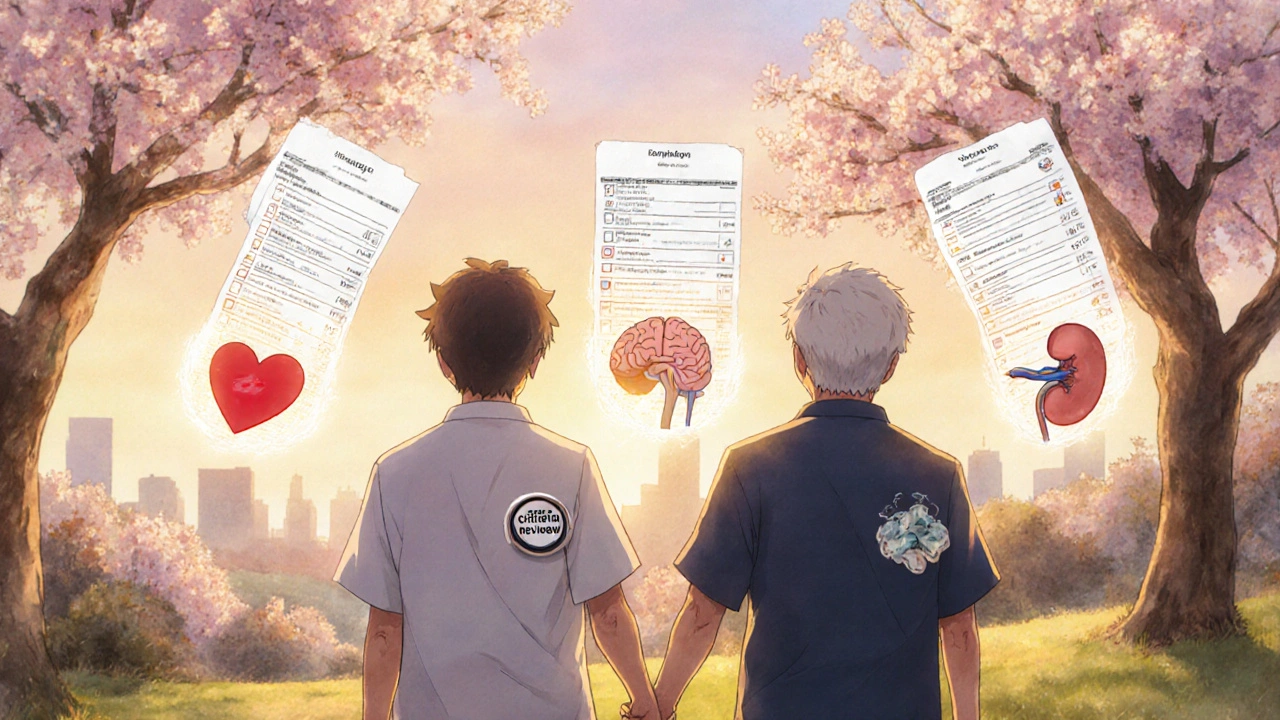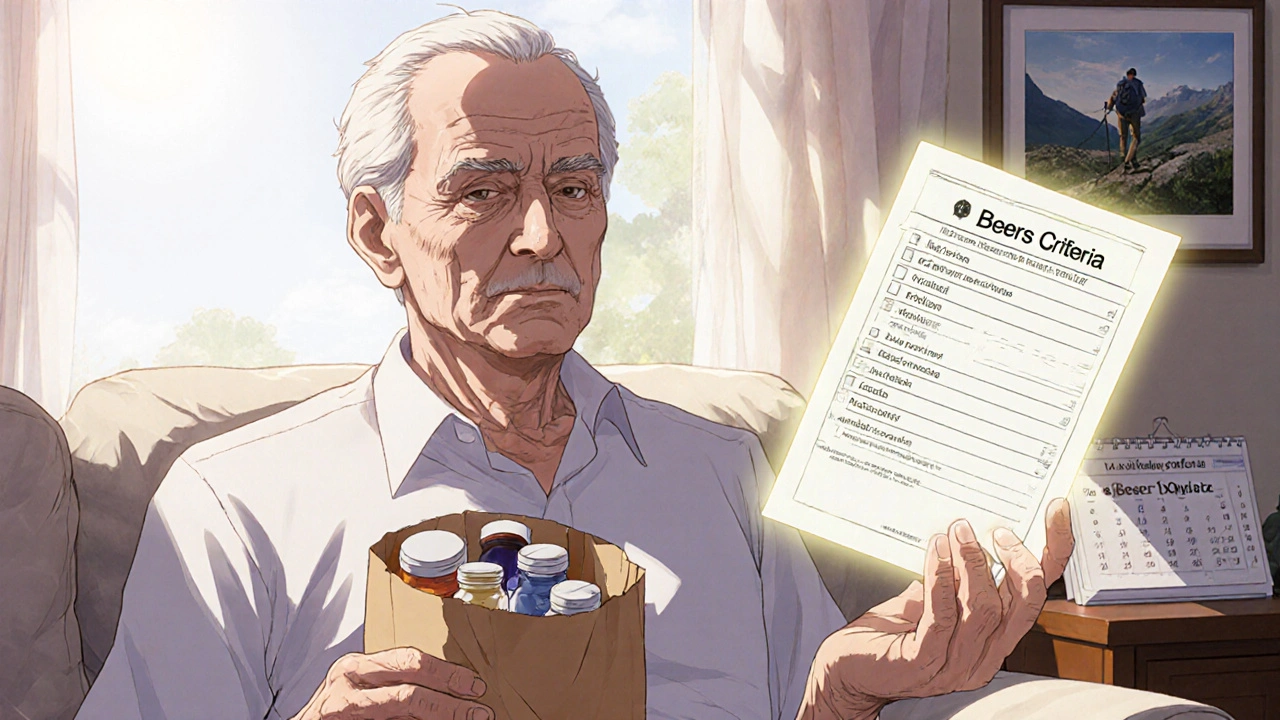Every year, tens of thousands of seniors end up in the hospital-not because of a fall, heart attack, or infection, but because of a medication they were prescribed. It’s not that doctors are careless. It’s that many common drugs, safe for younger people, become dangerous as the body changes with age. The truth is, high-risk medications for seniors aren’t always obvious. Some are over-the-counter sleep aids. Others are diabetes pills or antihistamines tucked into cold medicines. And many seniors take them without ever knowing the risks.
Why Seniors Are More Vulnerable
As we age, our bodies don’t process drugs the same way. The liver slows down. Kidneys filter less efficiently. Fat increases, muscle mass declines. All of this changes how medications are absorbed, broken down, and cleared from the body. A dose that was fine at 50 can become toxic at 75. Add in multiple prescriptions-40% of seniors take five or more drugs daily-and the chances of dangerous interactions skyrocket.The Beers Criteria: The Gold Standard for Safe Prescribing
The most trusted guide for identifying risky medications in older adults is the AGS Beers Criteria, updated every two years by the American Geriatrics Society. The latest version, released in May 2023, lists 30 classes of medications and 14 individual drugs that should generally be avoided in adults 65 and older. These aren’t random picks. Each was chosen based on real-world data showing higher rates of falls, confusion, kidney damage, or even death in seniors.Top 5 High-Risk Medications to Review Now
- Zolpidem (Ambien®) - This sleep aid increases fall risk by 82% in seniors. Residual drowsiness can last up to 11 hours, leading to confusion, sleepwalking, or accidents the next morning. Studies show 22% of users report falls requiring medical care.
- Glyburide (Diabeta®) - A sulfonylurea used for diabetes, it causes severe low blood sugar in nearly 30% of elderly patients. That’s more than double the risk of newer options like glipizide. Emergency visits for hypoglycemia are common, and some cases lead to seizures or coma.
- Diphenhydramine (Benadryl®) - Found in many OTC sleep and allergy pills, this antihistamine has a high anticholinergic burden (ACB score of 3). Long-term use increases dementia risk by 54%. It also causes dry mouth, constipation, urinary retention, and blurred vision.
- Nitrofurantoin (Macrobid®) - Often prescribed for urinary tract infections, it’s dangerous for seniors with even mild kidney problems. If eGFR drops below 60 mL/min, it can cause life-threatening lung damage. Mortality from pulmonary toxicity hits 18.3% in affected patients.
- Promethazine (Phenergan®) - Used for nausea and allergies, it can trigger severe movement disorders in seniors with Parkinson’s and doubles seizure risk in those with epilepsy. Many families report extreme drowsiness lasting over 24 hours after a single dose.
What About Common Prescriptions Like Blood Pressure Drugs?
Alpha-blockers like doxazosin, prazosin, and terazosin are still prescribed for high blood pressure-but they’re risky for seniors. These drugs cause a sudden drop in blood pressure when standing, leading to dizziness and falls. Seniors on these medications have 3.2 times higher risk of syncope (fainting) compared to those on safer alternatives like chlorthalidone or ACE inhibitors. In one study, 24.7% of elderly users experienced orthostatic hypotension-versus just 8.3% on chlorthalidone.
Why Are These Drugs Still Being Prescribed?
Many doctors don’t realize how dangerous these medications are for older patients. Some prescribe them out of habit. Others assume the patient is fine because they’ve taken them for years. But data shows most seniors don’t know their meds are risky. A 2022 Kaiser Family Foundation survey found that 58% of seniors on high-risk drugs had never been told about safer options. Only 32% said their doctor discussed potential side effects.What Are the Safer Alternatives?
- For insomnia: Switch from zolpidem to trazodone (a low-dose antidepressant) or try cognitive behavioral therapy for insomnia (CBT-I). Studies show CBT-I works better long-term than sleep meds and cuts fall risk by half.
- For diabetes: Replace glyburide with glipizide or metformin. Glipizide has a much lower risk of hypoglycemia and is easier for kidneys to handle.
- For allergies or colds: Avoid diphenhydramine. Use loratadine (Claritin) or cetirizine (Zyrtec) instead. Both have minimal anticholinergic effects.
- For UTIs: Use nitrofurantoin only if kidney function is normal. Otherwise, switch to fosfomycin or cephalexin, which don’t carry lung toxicity risks.
- For nausea: Replace promethazine with ondansetron (Zofran). It’s just as effective and doesn’t cause drowsiness or movement problems.
How to Get Your Medications Reviewed
You don’t need a specialist to spot risky drugs. Start with a brown bag review: Gather all your pills-prescription, OTC, vitamins, supplements-and bring them to your doctor or pharmacist. Ask: “Which of these are on the Beers Criteria list? Are there safer options?” Many Medicare Advantage plans now use electronic alerts in their systems to flag high-risk prescriptions. Ask if your provider uses Beers Criteria checks during visits. If not, request it. Pharmacists can also run an Anticholinergic Risk Scale (ARS) score on your meds. A score above 3 means you’re at high risk for confusion and memory problems.What You Can Do Today
- Check your medicine cabinet for diphenhydramine, zolpidem, or glyburide.
- Write down every medication you take-including doses and why you take them.
- Ask your pharmacist: “Are any of these on the Beers Criteria list?”
- Request a medication review with your doctor at your next appointment.
- If you’re on a high-risk drug, don’t stop suddenly. Ask about a safe taper plan.

Real Stories, Real Results
One 78-year-old woman took amitriptyline for nerve pain for 10 years. She developed severe constipation and was hospitalized. After switching to duloxetine, her symptoms vanished within weeks. Another man on glyburide had three hypoglycemic episodes in six months. After switching to glipizide, he went three years without a single episode. His energy improved. He started walking again.What’s Changing in 2025?
New rules are pushing change. In January 2024, Medicare Advantage plans began tying 5% of their quality bonuses to reducing high-risk prescriptions. Electronic health records from Epic and Cerner now auto-flag Beers Criteria drugs when prescribed to seniors. Pharmacies using Surescripts’ Real-Time Prescription Benefit tool now block 19% more risky prescriptions before they’re filled.Final Thought: It’s Not About Cutting Meds-It’s About Choosing Wisely
This isn’t about taking away medications. It’s about replacing dangerous ones with safer ones that actually work better for aging bodies. The goal isn’t fewer pills-it’s better pills. Seniors deserve treatments that protect their health, not harm it. A simple review can mean the difference between staying independent and ending up in the hospital.What is the Beers Criteria and why does it matter for seniors?
The Beers Criteria is a list of medications that are potentially inappropriate for adults 65 and older because they carry higher risks of side effects like falls, confusion, kidney damage, or death. Developed by the American Geriatrics Society and updated every two years, it’s used by doctors, pharmacists, and insurance plans to guide safer prescribing. Nearly all Medicare Advantage plans use it to shape their drug coverage.
Can I stop taking a high-risk medication on my own?
No. Stopping some medications suddenly-especially benzodiazepines, antidepressants, or blood pressure drugs-can cause dangerous withdrawal symptoms or rebound effects. Always talk to your doctor or pharmacist first. They can help you taper off safely or switch to a better alternative.
Are over-the-counter drugs really risky for seniors?
Yes. Many OTC sleep aids, cold medicines, and allergy pills contain diphenhydramine or other anticholinergics that are dangerous for older adults. Even one pill a night for months can increase dementia risk. Always read labels and ask your pharmacist before taking anything new.
How often should seniors have their medications reviewed?
At least once a year-but every six months is better if you’re on five or more medications. If you’ve recently been hospitalized, had a fall, or noticed new confusion or dizziness, schedule a review right away. Medicare requires annual medication reviews for beneficiaries enrolled in Medication Therapy Management (MTM) programs.
Who can help me review my medications?
Your primary care doctor, a geriatrician, or a clinical pharmacist can all help. Many pharmacies offer free medication reviews. Ask your pharmacist to check your list against the Beers Criteria. If you’re on Medicare, ask if you qualify for a Medication Therapy Management (MTM) program-they’ll do a full review at no cost.
